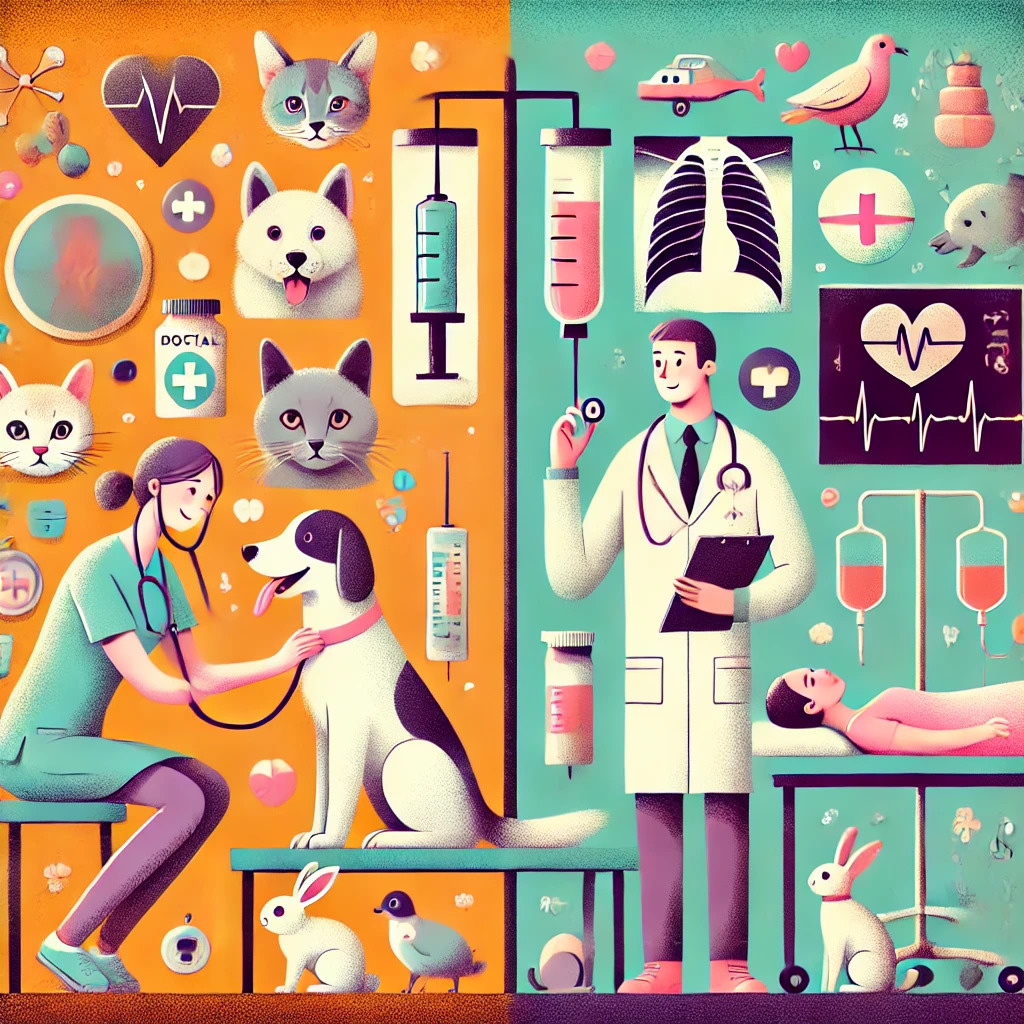
sen·tient /ˈsen(t)SH(ē)ənt/ adjective 1. able to perceive or feel things.
I recently presented at the Institute of Critical Animal Studies (ICAS) conference on “Recognizing Non-Human Animals as Sentient Beings”. I
Weeknights 7PM - Midnight
Weekends 8AM - Midnight

“… I sit down in every room, regardless of how far behind I am. Every patient knows they’re going to get that experience.”
He has described his house to be a bit of a zoo with three dogs: a bulldog named Tungsten, a miniature Golden Doodle named Bubbles and a miniature Teacup Yorkie named Luna as well as two guinea pigs. What was most impressive about our conversation with Dr. Hogan outside of his credentials was his compassion and focus on serving the patient; also a thread we saw with every veterinarian we spoke with as part of this series. This was our chance to sit down with Dr. MaCalus V. Hogan (MVH). It is hard to imagine he has any time for his patients let alone the ability to “sit down” with each and every one of them! After all, he currently serves as the Chair of the Department of Orthopaedic Surgery at the University of Pittsburgh Medical Center (UPMC), the
Chief of Foot and Ankle Surgery at UPMC, Vice Chair of Education and Residency Program Director in the Department of Orthopaedic Surgery at UPMC, a Professor of Orthopaedic Surgery, with secondary appointments in the Department of Bioengineering and the Katz School of Business for starters. More on that here. Our conversation began by discussing a common thread that we also touched on last week: technology.
PAD: We are curious to hear from your perspective what have been the most significant changes that you’ve seen since you started practicing medicine ?
MVH: I think one of the biggest changes is the advent of the electronic medical record. When you think about, years ago, everything was on paper. Some of the electronic activity was happening when I was a medical student, but I still remember we did everything on paper. We’d be writing orders on the floor, prescriptions, admission orders…anything that was needed was written. Even if you did a verbal order with a nurse during that time, they would then go write it in the chart and co-sign it! Now everything is essentially electronic and digital. It’s like going from the flip phone era to the Smartphone touchscreen.
PAD: Do you like the change? Growing up, someone would tell you their phone number. You’d either write it in down in a book and you’d usually memorize most people’s phone numbers. Today that’s not a thing. If you did math, you did it long form. If you did research, you looked it up. Do you think technology has hindered your student’s learning because they can have access quicker?
MVH: I can just reach for my phone and look up really quickly. Does that lead to not preparing for something as much? I did better when I read textbooks even if we had Powerpoints presented to us. We had laptops in Med school. I was that guy who if I don’t print it out or have some type of paper that I can highlight/ write notes on, it wouldn’t stick for me. But everybody is different.
I feel it’s amazing just how the genome has changed with technology as well. The things that I see that my kids can remember and absorb is fascinating. But at the same time to maintain that motivation to engage, I think that’s the key. I think that is upon all of us to be nimble and be able to adapt as technology evolves.
And technology is driven and advanced by necessity so that some of the mundane daily requirements can shift to automatic execution and become second nature; setting the stage for better business practice. Moving on to the business of medicine, we discussed healthcare vs. veterinary care. Are there similarities? What role does corporate governance play and has it changed the way medicine is practiced?
PAD: How has corporate governance affected the practice of medicine?
MVH: I’ve always enjoyed policy and how things flow. If you combine that with those who are taking care of the patients: nurses, pharmacists, physicians all the way down to the physical plant workers and the janitors who continue to clear the rooms and how to actually staff the medical assistance in every element, there is need for more structure. I’m a believer that structure is actually a positive thing. You need enough structure and guardrails for people to be able to take the best care of everyone and to continue to learn in that space. And it’s not simple. And so I believe that governance, when applied appropriately, actually can facilitate efficiency… It also facilitates communication. And I think that’s one of the biggest things that I’ve seen of value in healthcare. There needs to be a conversation that’s happening!
PAD: So it forces you to share results, communicate about results and learn from others?
MVH: It makes you better.
How profound! Open mindedness, collaboration and humility makes you better.
And what about quotas? We discussed the grace, skill and efficiency that is required to treat as many patients as possible without sacrificing level of care.
PAD: Do you ever feel or do you think that doctors in general feel pressure to see so many patients during the course of the day?
MVH: I would say to a degree there is a feeling of “How do we or how can we take care of the most people.” And that that’s how I look at it. And when I talk with my partners and our trainees, I actually speak to them about it. I say: “Hey, look! We are in the patient care business.” It’s also a patient relationship. And it’s also critical not just for us but for the communities we take care of. One of my mentors, Freddie Fu, who passed away, he (and Dr. Ferguson who also ran the department) would say: “ Take care of the patients, and they’ll take care of you. “ And so we’ve always kind of had that motto with our team. And I believe in that.
About that veterinarian shortage we discussed in Part 1, as it turns out, this is also happening in human medicine. The similarities are striking. Perhaps human medicine is more equipped to deal with this currently. Veterinary medicine can become more efficient the way human doctors have become. One of the benefits, Dr. Hogan suggests, is a result of corporate structure leveraging economies of scale. Do less doctors tax the system in a way that is untenable and/or are patients at risk?
While Dr. Hogan has acknowledged that the demands on the system have changed and more patients require more doctors, in most cases this can be handled by process and efficiency.
MVH: We have to do what we can to meet that need in the most sustainable and efficient way. We absolutely have to take what we’re seeing with patients coming in the door and we have to be able to be in the best situation and actually have the the resources to care for people to have the best outcome. I think it’s important for us to get routines and pathways and checklists to try to avoid the complications and the increased risk that can occur with seeing so many patients. And actually one of the things I do to try to level set myself , regardless of how many patients I see , I sit down in every room. I walk in. I hit the hand sanitizer, (which years ago it was a sink) and I sit every time. And regardless of how far behind I am, every patient knows they’re going to get that experience, too. It helps me ground myself to see each patient, recognizing that there are multiple things going on.That’s how I do it. So to me, it’s like getting in the cockpit of my plane with each patient; which is me and a co-pilot, where the patient is the co-pilot.
Dr. Hogan relies on his team: the nurses, the staff, the cleaning teams that turn the rooms over. All of these components lead to more efficiency. And with efficiency comes the discussion of cost.
Dr. Hogan is well aware of the “business” of medicine, but appears unfazed.
MVH: I’m not naive to the craft and business that we’re in. We do our part by just being a little more efficient each day, and being thoughtful about the decisions we make about the things that we use. I will say to my students sometimes: “If you sprained your ankle and you went to the doctor and the first thing you asked for was an MRI, just remind yourself that’s why you can’t pay back your Med School loans. From the age of 5 to 22, before you became a medical student, you never even thought about ordering an MRI for your ankle!”
The saying: “ the punishment needs to fit the crime” rings true here. As veterinarians we have to continuously strive to assure that our testing recommendations are commensurate with the condition presenting. It seems this discipline has been in practice for quite sometime in human medicine, where a judicious use of resources is the mechanism to contain costs.
PAD: Do you think that big business’ involvement in medicine has been overall a good thing?
MVH:I think it’s been overall positive. There’s some things that I remember from when I was a student. There were great stories but you ask should we really be doing it that way now? Was that driven by corporate America saying you should change how you do it? Or was it driven by just more structure and a streamlined process to get new ideas into implementation? I think we’re definitely better off today than we were before. We just have to figure out how to keep being better.
PAD: Is there any advice that you would offer to your veterinary counterparts as corporations continue to reshape the industry?
MVH: Be present and be engaged with your knowledge and expertise. Maintain a level of openness. If the focus is how can we be a little bit better each day or how can we really think forward and provide the best care…take that as a core value. You enjoy taking care of animals. Stay strong to your values, your morals and your ethics all around.
Words of wisdom crystallized one thing that all good doctors have in common: compassion, patience and care.
Build it and they will come
As we conclude this series, our discussion with Dr. Hogan gave us just the perspective we were looking for. We spent five weeks examining this complex issue of cost and care and it is obvious that veterinary medicine has a way to go. In human medicine, it seems that the drive to care for more patients efficiently is identified and resolved from the premise that doctors are part of the development process. Human medicine is by no means perfect. But it is more developed with many more solutions than can be found in veterinary medicine. This speaks to a mindset that so far, has been unchallenged. According to Dr. Hogan, collaborating with business development, insurance companies, other doctors and administrators is the way efficiency is developed and refined.
As it is today in veterinary medicine, big business entities working against their smaller acquired kin that they stand to profit from is a fools errand. Transparency and collaboration will yield better results. Dictate and bottom line focus does not work effectively, especially in a field developed and nurtured with compassion and kisses. If we are willing to take a page from the playbook of human medicine, it means we are, in fact, willing to look at our challenges with a different set of glasses. Instead of growth being the enemy, finding a way to embrace it may be the answer.
By Caroline Simard-Swimmer and Howard Swimmer

I recently presented at the Institute of Critical Animal Studies (ICAS) conference on “Recognizing Non-Human Animals as Sentient Beings”. I

Every year around this time pet owners are warned about toxic foods and holiday hazards. And while it’s important to

Life on the Inside: How to Keep Indoor Cats Happy (and Out of Trouble) There’s something fascinating about how differently
Pets After Dark is a subscription-based service that provides expert, local after-hours veterinary care.